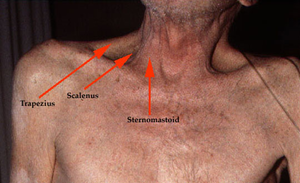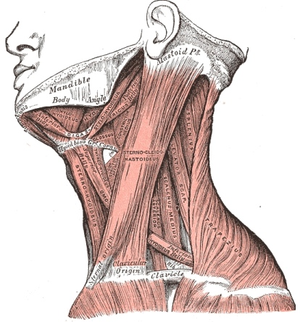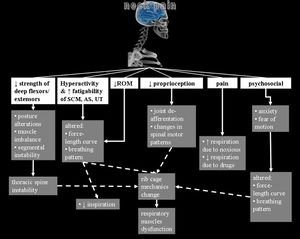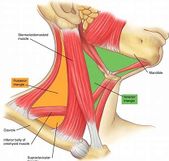Neck Pain and Breathing Pattern Disorders: Difference between revisions
Sarah Scott (talk | contribs) No edit summary |
Sarah Scott (talk | contribs) (reference) |
||
| Line 10: | Line 10: | ||
Breathing with normal respiratory mechanics has a potent role in the musculoskeletal system. Respiratory mechanics play a key role in both posture and spinal stabilization. Respiratory mechanics must be intact for both normal posture and spinal stabilization. There is a dynamic interaction between the key muscles of respiration. (Perri & Halford, 2003). Dysfunction in one can lead to a dysfunction in the other (co-dependency). | Breathing with normal respiratory mechanics has a potent role in the musculoskeletal system. Respiratory mechanics play a key role in both posture and spinal stabilization. Respiratory mechanics must be intact for both normal posture and spinal stabilization. There is a dynamic interaction between the key muscles of respiration. (Perri & Halford, 2003). Dysfunction in one can lead to a dysfunction in the other (co-dependency). | ||
[[File:Image neck pain and repiratory link.jpg|thumb|Kapreli et al (2008)]] | [[File:Image neck pain and repiratory link.jpg|thumb|Kapreli et al (2008)]] | ||
During respiration, there is a need of stabilized cervical and thoracic spine in order other muscles to act, moving the ribs up or down. In case of instability, rib cage could present mechanical alterations leading to insufficient respiratory dysfunction, influencing all muscles involved such as diaphragm, intercostals or abdominals due to adapted contraction pattern based on muscles’ force-length curve. Thus, it could be suggested that inspiration and expiration strength could be lessen in patients with neck pain. | During respiration, there is a need of stabilized cervical and thoracic spine in order other muscles to act, moving the ribs up or down. In case of instability, rib cage could present mechanical alterations leading to insufficient respiratory dysfunction, influencing all muscles involved such as diaphragm, intercostals or abdominals due to adapted contraction pattern based on muscles’ force-length curve. Thus, it could be suggested that inspiration and expiration strength could be lessen in patients with neck pain.<ref>A. Legrand, E. Schneider, P.A. Gevenois, A. De Troyer[https://www.sciencedirect.com/science/article/pii/S0306987707005646Respiratory effects of the scalene and sternomastoid muscles in humans Respiratory effects of the scalene and sternomastoid muscles in humans] | ||
J Appl Physiol, 94 (2003), pp. 1467-1472 | |||
</ref> | |||
| Line 30: | Line 33: | ||
[[Trapezius]] | [[Trapezius]] | ||
Scalene are invariably active during the inspiratory phase of breathing, even when the increase in lung volume is very small. The sternocleidomastoids are not active during resting breathing but they participate during strong inspiratory efforts. | Scalene are invariably active during the inspiratory phase of breathing, even when the increase in lung volume is very small. The sternocleidomastoids are not active during resting breathing but they participate during strong inspiratory efforts. | ||
Revision as of 10:31, 22 May 2019
Introduction
This document aims to provide information of how Dysfunctional Breathing Pattern disorders are associated with neck pain. Including information on; epidemiology, etiology, presentation of symptoms and provide recent evidence of the recommended management of the symptoms.
Definition/Description See breathing pattern disorders [1] See neck pain [2]
Breathing with normal respiratory mechanics has a potent role in the musculoskeletal system. Respiratory mechanics play a key role in both posture and spinal stabilization. Respiratory mechanics must be intact for both normal posture and spinal stabilization. There is a dynamic interaction between the key muscles of respiration. (Perri & Halford, 2003). Dysfunction in one can lead to a dysfunction in the other (co-dependency).
During respiration, there is a need of stabilized cervical and thoracic spine in order other muscles to act, moving the ribs up or down. In case of instability, rib cage could present mechanical alterations leading to insufficient respiratory dysfunction, influencing all muscles involved such as diaphragm, intercostals or abdominals due to adapted contraction pattern based on muscles’ force-length curve. Thus, it could be suggested that inspiration and expiration strength could be lessen in patients with neck pain.[1]
Evidence shows there is an association between neck pain and pulmonary function: A systematic review, included 68 studies, 9 were observational studies. The studies found a significant difference in maximum inspiratory and expiratory pressures with chronic neck pain compared to asymptomatic patients. Respiratory volumes were lower in patients with chronic neck pain. Muscle strength and endurance, cervical range of motion, lower Pco2 were also found to be significantly correlated with reduced chest expansion and neck pain. Respiratory retraining was found to effective in improving some cervical musculoskeletal and respiratory impairment. (Kahlaee et al, 2017)[2]
{{Https://youtu.be/I19V03 qqqA}}
Clinically relevant Anatomy
The thoracic spine and the interconnected muscles are responsible for normal inspiration and expiration. When breathing becomes harder work or altered the body compensates by recruiting the cervical Accessory Muscles. Scalenes
Trapezius Scalene are invariably active during the inspiratory phase of breathing, even when the increase in lung volume is very small. The sternocleidomastoids are not active during resting breathing but they participate during strong inspiratory efforts.
Epidemiology/etiology
- ↑ A. Legrand, E. Schneider, P.A. Gevenois, A. De TroyerRespiratory effects of the scalene and sternomastoid muscles in humans J Appl Physiol, 94 (2003), pp. 1467-1472
- ↑ [null Kahlaee], A. H., Ghamkhar, L., & Arab, A. M. (2017). The Association Between Neck Pain and Pulmonary Function: A Systematic Review. American Journal of Physical Medicine & Rehabilitation, 96(3). Retrieved from https://journals.lww.com/ajpmr/Fulltext/2017/03000/The_Association_Between_Neck_Pain_and_Pulmonary.12.aspxvidence B)










